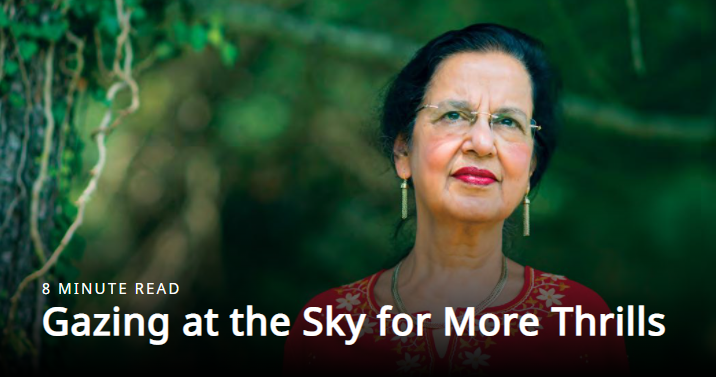Hashima Hasan played key role in launching of NASA’s Webb Space Telescope
BY ZAFAR IQBAL

“What are the odds of a girl born in the newly formed Republic of India to become a program/discipline scientist at NASA?” asked Hashima Hasan as she reminisced about her early school days during a recent NASA podcast interview.
The words of her sixth-grade teacher in Loreto Convent, Lucknow, that they could do anything if worked hard made a big impact on her. The all-girls educational institution established in 1872, had recently allowed girls to take STEM courses.
Inspired by the scientific career of her great-uncle Dr. Husain Zaheer (director general, India’s Council of Scientific and Industrial Research [CSIR]) and later on by her aunt Dr. Najma Zaheer, a renowned biologist, she took up the challenge and became interested in science.
Hasan says that her mother, a college graduate herself, had unwavering faith in her capabilities and encouraged her to pursue her ambitions. The inspiration to pursue space science was born when, in 1957, her grandmother gathered the entire family in her backyard during the early dawn to watch Sputnik I pass by — a fascinating sight in the clear sky. She was starstruck!
“When Sputnik was launched, it came out in the newspaper that you would be able to see it pass overhead at 5 in the morning. And my grandmother woke up everyone — the entire household — to see it. There was a big crowd in the backyard to watch Sputnik go by.
“Then, Yuri Gagarin made a tour of India. He came to our city — Lucknow — and there was a reception for him. My mother got invitations for all of us to see the cosmonaut. We were just little kids. We ran right to the stage — there was no security then — and said hello to him. He gave us little booklets and autographs. It was a big inspiration for me. I remember just staring at that booklet he gave me. I kept it for years.”
When NASA was formed, she eagerly followed every success and failure reported in the newspapers and clearly remembers the day that man landed on the Moon.
Hasan completed a BS, securing fifth position at Lucknow University. She followed this up with an MS (physics) at Aligarh Muslim University (AMU), where she secured first place and a gold medal. She started her doctoral MPhil program under the tutelage of the legendary AMU physics professor Dr. Zillur Rahman Khan, and took the bold step of applying for doctoral studies at Oxford University in 1973. Encouraged by Dr. Rais Ahmad (head, Department of Physics, AMU), she applied for and received a Commonwealth Scholarship and joined Oxford.
Three years later, with a DPhil (theoretical nuclear physics) in hand, she returned to India as a postdoctoral scholar at Mumbai’s Tata Institute of Fundamental Research (TIFR). With scholars like astrophysicist Dr. J. V. Narlikar (emeritus professor, Inter-University Centre for Astronomy and Astrophysics) — who, along with Sir Fred Hoyle, developed the conformal gravity Hoyle–Narlikar theory — and Dr. Obaid Siddiqi (founder-director, TIFR National Center for Biological Sciences; d.2013;), TIFR was a haven of intellectual thought.
After two intense years at TIFR, she secured a faculty position in physics at the University of Poona, Pune. While there, as the only non-Marathi-speaking faculty member,
she recalls that the atmosphere was welcoming, respectful, academic, and idyllic. She enjoyed teaching the postgraduate students.
Her life took an important turn after her marriage to Dr. Aftab Ansari (scientific officer, National Institutes of Health) and move to Raleigh, N.C. to join him. She pursued her passion for nuclear physics at Duke University, switching gears two years later to atmospheric science when the U.S. National Research Council awarded her a resident research associateship. data archives; or management of advisory committees and communication with educators and the public.
Hasan has managed every aspect of astrophysics during her more than 27 years at NASA headquarters. One of her significant responsibilities is that of working as the deputy program scientist of the James Webb Space Telescope (JWST), a successor to the Hubble. Her responsibilities have included oversight during the mission development phase to make sure that the
HASAN HAS MANAGED EVERY ASPECT OF ASTROPHYSICS DURING HER MORE THAN 27 YEARS AT NASA HEADQUARTERS. ONE OF HER SIGNIFICANT RESPONSIBILITIES IS THAT OF WORKING AS THE DEPUTY PROGRAM SCIENTIST OF THE JAMES WEBB SPACE TELESCOPE (JWST), A SUCCESSOR TO THE HUBBLE.
A year later, the couple was back in India, this time with an infant son. Her first experience as a working mother came when she started research in nuclear physics at Mumbai’s Bhabha Atomic Research Center. When they returned to the U.S. with their second son, her journey took a turn toward NASA.
Arriving in Baltimore, she sought research opportunities and was hired by the newly formed Space Telescope Science Institute to write simulation software for the optics of the soon-to-be-launched Hubble Space Telescope and its science instruments. Never one to turn down a challenge, she once again switched gears from nuclear physics — this time toward optics and astronomy.
Little did she know that within a few years she would be using her software to analyze the Hubble mirror’s optical error and made responsible for keeping it in the best focus until a fix was designed.
After the first servicing mission repaired the Hubble, she took advantage of an opportunity at NASA headquarters in Washington D.C. to work as senior scientist. Thus began her career in science management. “There was never a dull moment at NASA headquarters,” she says. Every second keeps one intellectually on the edge — whether it is the strategic planning for the next flight mission; the solicitation, review and selection of new technology, research program and payloads on sounding rockets and balloons; the next Explorer mission; direction of the science requirements were being met and that the best science observation program was selected for the operation phase. She is currently serving as JWST spokesperson to the media and delivering invited talks to school students.
After many years of hard work with its partners, the European Space Agency and the Canadian Space Agency, NASA launched JWST from the European spaceport of Kourou, French Guiana, on Dec. 25, 2021. The telescope, equipped with multiple instruments, will be positioned at Lagrange Point 2, located 1.5 million kilometers from Earth or more than four times beyond the Moon. Its mission stretches from five to 15 years. In her position at JWST, she was part of the team on board when the world’s largest and most powerful telescope was launched. This was an exhilarating moment for her, the entire JWST team and indeed the entire world.
Once in operation, JWST will show the wonders of the universe never seen before. The world is eagerly waiting for those first science images. Hasan is gazing at the night skies at her home in the U.S. with the same wonder that she gazed at it as a little girl in Lucknow — it is the same sky with the same mysteries waiting for all of us to discover.
Zafar Iqbal, Ph.D. (All-India Institute of Medical Sciences, New Delhi, in 1972), served as a faculty member at the Northwestern University Medical School in Chicago. From 1994-2020, he served as scientific review advisor with the Veterans Health Administration. He has served with several scientific, literary, social and cultural organizations in the U.S.
This article is also published at: https://issuu.com/isnacreative/docs/ih_march-april_22/s/14946092
Management
-----------------------------------------
Trustees
Tariq Farooqi (Chair)
Fazal Khan
Khurshid Usmani
Masood Farshori
Abdullah Abdullah
Directors
Aslam Azad (President)
Mohammed Akbar (Secretary)
Ariena Rashid (Treasurer)
Send Email to us by clicking here

 Aligarh Alumni Association
PO Box 1877, Ellicott City MD 21041
Aligarh Alumni Association
PO Box 1877, Ellicott City MD 21041